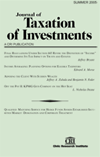Why Tax Inversions Continue to Be an Effective Global Tax Planning Strategy
Author: Paul M. Schmidt.; John D. Bates.; Jeffrey H. Paravano.
Source: Volume 32, Number 02, Winter 2015 , pp.3-9(7)

next article > |return to table of contents
Abstract:
The number of “inversions”—mergers or acquisitions in which U.S.-based companies become foreign companies or owned by foreign parent companies—has surged in recent years. Inresponse to this wave of transactions, the U.S. Treasury Department recently issued Notice 2014-52, applicable to transactions completed on or after September 22, 2014. The notice tightens existing restrictions and limits certain post-inversion tax planning strategies, thereby precluding certain transactions and reducing the tax benefits available. Although the notice is likely to slow the wave of inversions, there continue to be tax benefits to inverting, and only comprehensive tax reform can eliminate these incentives. Inversions, thus, will continue unless and until Congress tackles tax reform, an unlikely prospect in the near term.Keywords: inversion; Notice 2014-52; Treasury; international tax; trapped cash; tax reform
Affiliations:
1: Baker & Hostetler LLP; 2: Baker & Hostetler LLP; 3: Baker & Hostetler LLP.